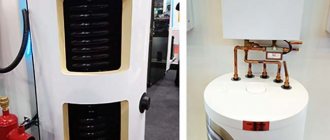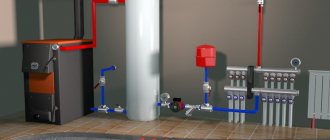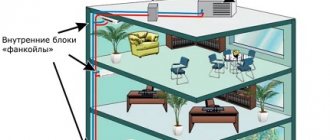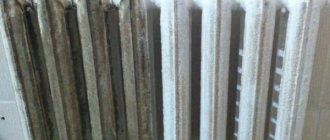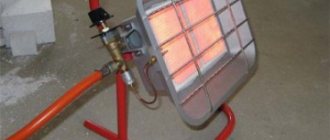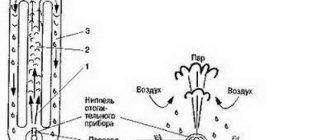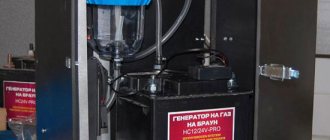Not a single residential building can function normally without a climate system, thanks to which a comfortable temperature for people to live in is achieved in the rooms. There are a huge number of different schemes, but the simplest and most inexpensive is a single-circuit heating system, the features of which you can construct with your own hands will be discussed below.
Single-circuit heating circuit - an inexpensive and effective heating method
Description of the scheme
Components
Single-circuit heating differs from other piping schemes in the number of lines used. Here, one pipe is used to supply coolant to the radiators and return the cooled liquid to the boiler.
Only conditionally it is divided into two sections:
- supply line;
- return line (return).
In a single-pipe system (pictured), both the supply and removal of coolant are carried out through one pipe
In addition to pipelines, the heating system under consideration includes the following components:
| Name | Description |
| Boiler | The main character. It is here that the thermal energy obtained from fuel combustion is transferred to the coolant (water or antifreeze). Then the liquid through the pipes enters the radiators, where a secondary exchange occurs - the heat of the water is transferred through the walls of the radiators to the air and objects in the room. |
| Radiators | Basic heat exchange equipment. They are installed in all rooms that need to be heated. Without them, it would be impossible to organize effective heat exchange, since the pipe area is often not enough to heat the premises. |
| Expansion tank | It is necessary to compensate for pressure in a closed heating and storage system of water, which increases in volume when heated. There are open and closed types. The latter are preferable, since they prevent the evaporation of the coolant and can be installed on any part of the system (and not just at its highest point). |
| Accessories | This includes all other small, but no less important parts: shut-off valves, thermal valves, Mayevsky taps, and so on. |
In addition to pipes and a boiler, other devices are needed to install a heating system
Note! There is a single-pipe heating circuit with natural and forced circulation of liquid through the pipes. In the latter case, a mandatory element of the installed climate network is a circulation pump that pumps the coolant.
Advantages and disadvantages
The described heating circuit works as follows: the heated liquid becomes less dense and lighter, therefore it is displaced by heavy cold water to the upper point of the heating system.
Then, as it cools, the coolant falls down, simultaneously flowing through all installed radiators and giving off the accumulated heat to the air in the rooms. Therefore, batteries located closer to the boiler (or on the upper floors) heat better. This is one of the most serious disadvantages of single-circuit heating.
The single-pipe system does not allow you to regulate the volume of coolant entering the heating radiators
To compensate for temperature differences, radiators located closer to the heater have a smaller heat exchanger area, while those furthest away are constructed from more individual sections, which increases their power.
There are several more ways to increase the efficiency of a single-circuit heating system:
- Installing a circulation pump . In this case, the liquid flows through the heating devices more intensively, resulting in an increase in the efficiency of the entire climate network.
- Correct placement of radiators. To reduce heat loss, it is recommended to install the batteries closest to the boiler, if possible, in the warmest rooms - interior rooms with a minimum of windows.
To ensure uniform heating of the rooms, it is necessary to install large heating radiators
On the other hand, single-circuit heating is still quite popular.
It is widely used in individual construction, as it has many advantages:
- low installation price - for installation you need to buy a minimum of pipes and other fittings, the cost of paying for the services of installation crews is also reduced;
- more aesthetic appearance - since there is only one pipe, it is easier to hide, disguise or concrete into the wall (floor);
- the ability to select the flow of hot water - the inclusion of certain circuits is carried out using manual or automatic shut-off valves;
- possibility of laying pipelines under interior doors.
Note! The exact layout of the pipelines directly depends on the layout of the house. It is necessary to choose places that guarantee a minimum amount of heat loss.
The heating system of a large house requires a circulation pump
Remember that effective fluid flow cannot be achieved naturally in the following cases:
- the total area of the house exceeds 200 square meters;
- the length of the contour is more than 30 meters;
- More than 10 heating radiators are connected to one heating circuit.
In this case, you will still have to install a circulation pump or buy a boiler already equipped with one.
Connecting an indirect heating boiler to a single-circuit boiler - diagram
According to the diagram, you need to find the terminals for the boiler sensor in the boiler and connect the ends of the wires to them.
Conventional indirect heating boilers work mainly with automated boilers.
Connecting the boiler to the boiler using a three-way valve This connection diagram is perfect for gas boilers equipped with a circulation pump and automation. Preference is given to wall-mounted models that can be hung at a height of 1 m above the floor.
The best position is when the bottom of the hot water tank is higher than the heating boiler and radiators. How to properly connect an indirect heating boiler to a heating system? They are less often connected to free-standing boilers of similar volume.
More on the topic: How to connect a two-key switch
Indirect heating boiler design
Indirect heating These water heaters do not produce thermal energy themselves. If you need to create a connection diagram for a solid fuel boiler that runs on wood, we recommend choosing the option shown in the picture below. Some manufacturers deliberately produce equipment with standard dimensions of connectors and fittings.
In this scheme there is no three-way valve; the circuit is connected through ordinary tees. With this part, the unit lasts much longer. Operating at very high temperatures can cause premature damage to the inside of the tank. Types of double-circuit gas boilers with a built-in boiler, are they needed? Boilers are used in conjunction with single- and double-circuit gas boilers. The circulation pump is common here; it circulates the coolant through the heating circuit and through the water heater.
How to connect an indirect heating boiler (water heater)
Scheme for connecting an indirect heating water heater to a gravity system When implementing this scheme, the circuit that goes to the water heater is made into a pipe with a diameter 1 step larger than the heating one. They have a coil and a built-in heating element.
This piping method is useful for those who use the boiler in constant mode 2: Option with two circulation pumps If the boiler is used rarely, for example, seasonally or on weekends, or there is a need for water whose temperature is lower than in the heating system, use a scheme with two circulation pumps . The heating system of an apartment or house is working, and the water in the boiler is heating up as if in passing as a side effect. A boiler connected to heating equipment and electric heating elements. This method is only possible if you have separate boiler equipment that can operate from natural heating sources in the form of liquefied gas, coal or firewood all year round. The hot water supply circuit also has higher priority over the heating circuit, but this is achieved only by adjusting the switching algorithm. Performing piping requires preliminary competent thermal calculations. Ufa. Connection diagram for an indirect heating boiler.
Thermal calculation
Indoor comfort depends not only on the layout, but also on the amount of thermal energy that the batteries release to the air in the rooms. Therefore, in order not to freeze in winter, you need to make the correct thermal calculations. By the way, this is also indicated by the instructions enshrined in the current SNiP.
Thanks to the correct calculation, you can choose:
- boiler of the required power - a weak one will not be able to heat the house, a powerful one will burn expensive energy resources in vain;
- radiators of the required area - this will help to significantly reduce the cost of their purchase.
Calculations can be made independently (using a special computer program) or contact a specialized engineering company. The second option is more expensive, but this way you will be sure that the data provided to you is correct.
Before installing heating, you need to perform a thermal engineering calculation of the structure
In addition, the engineers of this organization will also prepare a diagram of the heating circuits, drawn on the provided plan of your house (apartment). This will greatly facilitate installation and help you buy the right amount of materials.
Popular single-pipe heating system: 4 main features
The single-pipe heating system is very popular today. One of the main problems that you certainly have to face when reconstructing, building or renovating a house is heating. A lot of time and close attention is given to this issue. In private country houses, when heating, it is customary to install a single-pipe water system. Because it is easy to use and more effective than others.
Content:
In a private house it will be more efficient to install single-pipe heating. As you can tell from the name, in this system the circulation of heat from the boiler occurs through one pipe (main), which forms a ring. This closed ring begins with her and ends with her. Heating devices are also connected to it, which can be located one after another or in parallel.
The main advantage of a single-pipe system can be considered its very simple design. At the same time, the ease of installation is very reliable and effective, and the price of this system is absolutely acceptable. And another plus is that such a system can be easily hidden and then it will not spoil the aesthetic appearance of the house.
The main component of such a heating system is the boiler. Its fuel is natural gas. Another important element is radiators. They are the sources of heat. Today, bimetallic radiators are in demand. They heat the room much better and look more interesting than cast iron radiators. To stabilize the pressure in the system, it is customary to install an expansion tank in which excess moisture can collect when heated.
The principle of operation of a single-pipe heating system
Features of a one-pipe system:
- Does not have a large number of pipes;
- The internal diameter of the pipes is the same along the entire length of the system;
- Each subsequent radiator loses its original temperature;
- The reverse process does not take place.
In many single-pipe systems, it is customary to install a circulation pump. Such a pump runs on electricity; it is capable of creating stable operation of the entire pipeline, forcing the movement of coolant through the pipes. To supply coolant, Mayevsky taps are installed. The entire system is very robust and reliable.
Reliable one-pipe heating system: diagram and types of connections
The heating system, which has a single-pipe system, has two types of wiring: vertical and horizontal. Vertical wiring is usually installed in two-story buildings, where the radiators are located one above the other. Its main advantage is that it is capable of moving coolant naturally. But horizontal wiring is found in one-story houses. The layout of such a wiring with a bottom connection generally suits the owners of houses whose area is small.
Basically, the single-pipe heating scheme is not complicated. It consists of the most important elements of the system: the boiler, risers and their connections, radiators, adjacent taps, as well as an expansion tank. With this diagram you can see all the main details.
But the batteries themselves can be connected to the main line in three main ways. Each of them has its own advantages and disadvantages. They are completely different from each other.
A single-pipe heating system has two types of wiring
Three battery connection options:
- Lateral connection;
- Bottom connection;
- Diagonal connection.
The bottom connection, according to some reviews, can reduce the heat transfer of radiators, but at the same time they are practically invisible and do not spoil the entire interior of the room. The best solution would be to connect the batteries diagonally. Such a flow system will warm up the radiator entirely, and the radial heat transfer will increase. Therefore, it is best to connect the batteries from different sides.
Simple single-circuit heating: diagram and step-by-step installation
Single-circuit or, as it is commonly called, single-pipe heating is usually used in houses whose area does not exceed 200 square meters. It is best to do such heating in rooms inside the house, where there are the fewest windows, then its efficiency will be much higher.
The placement of pipelines depends on the accuracy of the drawn up diagram. If you can install the heating yourself, then it is best to entrust drawing up the diagram to specialists.
A calculation needs to be made not only of the layout, but also of the amount of heat that the radiator will give off. This calculation is called thermotechnical. It is done in special engineering services. Specialists will make competent and correct calculations, this, in turn, will facilitate installation and allow you to purchase the right amount of material used. Then you can manually install everything correctly.
Scheme of a single-circuit heating system
Sequential installation of a single-circuit system:
- We install the boiler at the very bottom of the system;
- We install radiators behind the level;
- We install polymer or steel pipes; this must be done on an incline;
- Then we attach all the other additional elements: expansion tank, electric pump, taps, and so on;
- The last stage is crimping, it is carried out using a pneumatic device and is done by a specialist.
When making a project for such heating, you need to concentrate your attention on the highway; it must be straight, without any turns. Otherwise, the efficiency of all heating will be greatly reduced.
Single-pipe heating system in a private house: its advantages
Today, many country private houses use single-pipe water heating. The circuit of this heating has the main elements: a boiler, radiators, pipes and of course an expansion tank. This system has significant advantages that distinguish it from other systems.
We can note such advantages as: high heat transfer, pipes suitable for medium diameters, as well as excellent heat capacity. In winter, such a water system should under no circumstances be left idle. Because main pipes can burst, and this will lead to flooding of the room.
This heating system is only suitable for houses with a small area. But using it in other areas would be irrational. But still, such a system has its advantages, which makes it popular.
A single-pipe heating system in a private house has high heat transfer
The advantages of a single-pipe system:
- Cheapness;
- Simplicity;
- Reliability;
- Efficiency;
- Aesthetics;
- Economical.
This heating system attracts many people with its low cost and ease of assembly. The system has disadvantages, one of them is of particular importance. And it lies in the fact that if one of the heating devices breaks down, the entire system suffers - it becomes inoperable.
Construction of a single-pipe heating system (video)
Heating of houses can be carried out by installing one of the types of heating in the home: single-pipe or two-pipe. Whatever you choose, the most important thing is that it must be installed correctly and reliably, and for this, competent calculations must be made. Then, properly installed heating will provide very effective heating in winter.
homeli.ru
Varieties of single-circuit circuits
With vertical wiring system
In this case, the coolant heated by the boiler rises through a vertically installed riser to the highest point of the heating network (into the attic or under the ceiling of the top floor), from where it then flows down, simultaneously heating the radiators located on each floor of the house.
Features of the design and operation of vertical heating circuits are as follows:
- the coolant can be moved naturally, without the use of electrical equipment;
- all sections of pipes should be laid with a slight slope towards the boiler in order to increase the intensity of water circulation and avoid the formation of air pockets;
- it is difficult to hide pipes in walls, since in this case you are unlikely to be able to maintain the slope;
- The system operates completely autonomously, so even in the event of an emergency power outage, you will not be left without heat.
Scheme of single-circuit heating with vertical wiring
With horizontal wiring system
The vertical riser is not mounted here. The main pipeline is laid along the floor or under it. If you decide to disguise pipes in a concrete screed, take care of their thermal insulation, otherwise quite significant heat losses cannot be avoided.
In addition, it is advisable to observe the slope in this case:
- firstly, the heating network will be able to operate (albeit less efficiently) during a power outage;
- secondly, when filling pipes with liquid, you will avoid the formation of air locks.
Single-circuit connection diagram with horizontal wiring
Methods for connecting radiators
Here we will not consider individual battery designs and options for placing pipes (bottom, side, etc.). Let's focus only on the pipework. All options for connecting radiators are shown in the table.
Flow-through connection of radiators
| View | Description |
| Flow-through | In this case, the heating circuit is connected to the inlet and outlet pipes of the battery. Water flows through each radiator installed in the system, since there is simply no other way for it. This connection does not allow you to regulate the intensity of the heating devices. In addition, if heating devices leak, you will have to completely stop the heating system and drain the coolant. |
| Closing | Here, the incoming and outgoing pipes of the battery are also connected by a bypass section of the pipe (the so-called bypass). You need to take a part whose diameter is slightly smaller than the main supply circuit. Water entering the battery is distributed into two flows: into the battery and into the bypass. By installing a thermal valve on the inlet pipe, and shut-off valves on the outlet and bypass, you can easily regulate the temperature in the rooms and replace batteries without stopping the operation of the general heating. |
Battery with a bypass pipeline section
Brief description of the device
The designs of modern gas boilers are approximately the same. Depending on the modification, some heaters may have additional elements.
In this video we will look at the difference between single-circuit and double-circuit boilers:
The main details include:
- A gas burner consists of a rectangular body containing nozzles that supply gas to the combustion chamber. They evenly distribute fuel throughout the burner, which ensures uniform heating of the coolant.
- The heat exchanger is a metal box with a radiator inside. It heats the coolant, which enters the heating system.
- A circulation pump is a unit that creates pressure in the gas heating line. Some models do not have it.
- The expansion tank ensures the removal of coolant during strong heating and expansion.
- The design for the exit of combustion products provides a connection to the chimney for the removal of exhaust gases.
- Control system - a unit for automatic control and operation of heating system equipment.
Read more: DIY chimney.
There are boilers that, in addition to the heating system, provide heating of the coolant for hot water supply. Such units are called geysers.
Installation of a single-circuit heating system
The construction of a climate network with one pipeline is carried out in the following sequence:
- The boiler is being installed . For obvious reasons, it must be mounted at the lowest point of the system. The greater the height difference between the radiator and the heater, the better the heat exchange in the system.
The boiler must be located below the level of the radiators
If you do not have the opportunity to install the unit in the basement, you need to equip it with a pit cast from concrete and lined with ceramic tiles.
Note! If you decide to make a system with forced circulation, you don’t have to resort to such tricks. However, by placing the heater in the manner described above, you will make the heating system more independent of public utilities.
- Radiators are being installed . Here you need to strictly observe the horizontal and vertical, otherwise mineral deposits will accumulate in the batteries, which sooner or later will clog all the channels. Because of this, you will have to either clean or change the devices.
It is also necessary to maintain the distance between the battery and the structural elements of the building. Violation of the technology for hanging the battery will result in poor air circulation around it. This will negatively affect the performance of the device.
When installing batteries, keep an eye on the level.
- Pipeline installation . Here you need to decide on the pipe material. The most common climate networks are made of polymer parts, however, if part of the system is a solid fuel boiler, it is better to prefer steel ones. The mentioned unit heats the coolant to a temperature exceeding 95 degrees Celsius, which is very harmful for plastic pipes.
Pipes in a single-pipe system must be laid at a slope
- Installation of additional elements. Electric pumps, control and regulating equipment, an expansion tank, air valves, and so on are installed.
- The last stage of work is crimping . To carry it out, it is better to invite a qualified worker with a special pneumatic device.
The final stage of work is heating pressure testing
How to turn a single-circuit heating boiler into a double-circuit heating boiler?
You cannot make a double-circuit boiler from a single-circuit boiler. Therefore, either leave everything as is or change the boiler. But first of all, think about this type of boiler. Secondly, I know from personal experience that there are constant interruptions in hot water. That is, they turned on the water, but it didn’t immediately get as hot as the boiler, so you still have to drain the water. In winter, when someone bathes or just washes dishes, the heating turns off completely. This is a small minus. Even when a person is bathing and if you turn on the water in another tap, the water for the person who is bathing will start to run cold! Plus, if the water is hard, it will cause more scale; a boiler is better suited to this than a boiler. Gas is now more expensive than electricity. You can install a day-night meter, then using the boiler will become even more profitable. So think about it, maybe you’re lucky, on the contrary, that the boiler is separate and the heating is separate. The only negative is that the boiler takes up a decent amount of space, but it can still be allocated.

